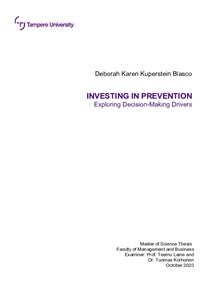Investing in Prevention: Exploring Decision-Making Drivers
Kuperstein Blasco, Deborah Karen (2020)
Kuperstein Blasco, Deborah Karen
2020
Master's Programme in Industrial Engineering and Management
Johtamisen ja talouden tiedekunta - Faculty of Management and Business
This publication is copyrighted. You may download, display and print it for Your own personal use. Commercial use is prohibited.
Hyväksymispäivämäärä
2020-10-20
Julkaisun pysyvä osoite on
https://urn.fi/URN:NBN:fi:tuni-202010157350
https://urn.fi/URN:NBN:fi:tuni-202010157350
Tiivistelmä
Investing in prevention is a pressing issue that is still underexplored. Though investing in prevention is common for sectors such as public health and even mandatory for certain as-pects like car insurance, it is difficult to assess the value of prevention. Investing in prevention is not as straightforward as other investments given that benefits from prevention are delayed in time and difficult to assess. While people commonly associate products and services of prevention with purchasing insurance policies or other items of public health, there are myriad less evident forms of prevention; these include products and services that seek to deter cli-mate change. Interestingly, when we think about ‘clean’ technologies, we seldom describe them as preventive. Environmental investments seek to ameliorate climate change; for these invest-ments, the element of prevention is avoiding future negative consequences for oneself, an or-ganization or the community. This variance of scope of an investment in environmental preven-tion poses additional challenges on how to assess and communicate value.
Understanding why people invest in prevention and acknowledging the preventive quality of certain solutions could shed light on how to influence their rate of adoption. Both for the socie-ty’s general wellbeing and for businesses whose success relies on preventive behavior, it is imperative to understand how to initiate and push forward an investment in prevention. There-fore, identifying and understanding the drivers of investments in prevention offers an interest-ing and multifaceted research opportunity, particularly for investments related to environmental protection.
The objective of this thesis is to identify and examine decision-making drivers for invest-ments in prevention. The context of this study was within two case projects with an environmen-tal focus: adoption of black carbon environmental innovations and the selection of sustainable building materials. This objective was achieved through a combination of theoretical and practi-cal work based on the Switching Path Analysis Technique (SPAT), a methodology to study supplier switching processes. For this, a literature review explored the topics of customer val-ue, technology and innovations, decision-making processes, management accounting for deci-sion-making, and investment in prevention. Then, a theoretical framework was created to shed light on decision-making drivers, participants and management accounting tools in use. The framework was applied to study a series of completed investment decisions in prevention re-lated to environmental protection.
Findings on this thesis illustrate a series of decision-making drivers for investments in pre-vention. This study shows that an investment in prevention starts with a decision-making entity that presents preventive behavior (that is, has a lifestyle oriented towards prevention, or con-siders prevention as a decision-making criteria). This customer might experience an internal or external stimulus that helps identify that something is not in line with prevention-focused goals and therefore, seeks to invest in a solution that fulfills these goals. Finally, the use of future-illustrating management accounting tools, such as total cost of ownership was identified as purposeful for organizations that supply products or services of prevention as they depict lifecycle benefits, however acknowledging that these tools might not always ensure the best value for money perspective. Based on these findings, this thesis illustrates a series of practi-cal and managerial implications for organizations whose success relies in some way on preven-tive behavior. This work helps illustrate the versatility of the concept of prevention, thus making findings applicable for diverse settings of prevention.
Understanding why people invest in prevention and acknowledging the preventive quality of certain solutions could shed light on how to influence their rate of adoption. Both for the socie-ty’s general wellbeing and for businesses whose success relies on preventive behavior, it is imperative to understand how to initiate and push forward an investment in prevention. There-fore, identifying and understanding the drivers of investments in prevention offers an interest-ing and multifaceted research opportunity, particularly for investments related to environmental protection.
The objective of this thesis is to identify and examine decision-making drivers for invest-ments in prevention. The context of this study was within two case projects with an environmen-tal focus: adoption of black carbon environmental innovations and the selection of sustainable building materials. This objective was achieved through a combination of theoretical and practi-cal work based on the Switching Path Analysis Technique (SPAT), a methodology to study supplier switching processes. For this, a literature review explored the topics of customer val-ue, technology and innovations, decision-making processes, management accounting for deci-sion-making, and investment in prevention. Then, a theoretical framework was created to shed light on decision-making drivers, participants and management accounting tools in use. The framework was applied to study a series of completed investment decisions in prevention re-lated to environmental protection.
Findings on this thesis illustrate a series of decision-making drivers for investments in pre-vention. This study shows that an investment in prevention starts with a decision-making entity that presents preventive behavior (that is, has a lifestyle oriented towards prevention, or con-siders prevention as a decision-making criteria). This customer might experience an internal or external stimulus that helps identify that something is not in line with prevention-focused goals and therefore, seeks to invest in a solution that fulfills these goals. Finally, the use of future-illustrating management accounting tools, such as total cost of ownership was identified as purposeful for organizations that supply products or services of prevention as they depict lifecycle benefits, however acknowledging that these tools might not always ensure the best value for money perspective. Based on these findings, this thesis illustrates a series of practi-cal and managerial implications for organizations whose success relies in some way on preven-tive behavior. This work helps illustrate the versatility of the concept of prevention, thus making findings applicable for diverse settings of prevention.
